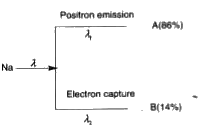Na22 has half life of 2.68 years . It decays both by positron emission and electron capture with a ratio of 86% of the former to 14% of the later . The half life for positron emission in years (nearly) is ……….Solution in Telugu
The correct Answer is:3

t1/2=0.693λ1=0.6930.2224=3.116≡3,YA=λ1λ×100=86lλ=0.6932.68……….(2)
YB=λ2λ×100=14,λ=(λ1+λ2)……...(3)⇒λ1λ2=8614......(1) From (1) , (2) and (3)
λ=(λ1+λ2)=0.6932.68,(λ1+14λ180)=0.2586,λ1(1+1480)=0.2586
λ1=0.2586×86100=0.2244,t1/2=0.693λ1=0.6930.2224=3.116≡3
Topper's Solved these Questions
- BOOK - AAKASH SERIESCHAPTER - NUCLEAR CHEMISTRY EXERCISE - PRACTICE SHEET - 1 (Single or more than one option questions)15videos
NUCLEAR CHEMISTRY
- BOOK - AAKASH SERIESCHAPTER - NUCLEAR CHEMISTRY EXERCISE - PRACTICE SHEET - 1 (Linked Comprehension type questions )6videos
NUCLEAR CHEMISTRY
- BOOK - AAKASH SERIESCHAPTER - NUCLEAR CHEMISTRY EXERCISE - LECTURE SHEET (LEVEL- II) (EXERCISE - III) (Match the following questions )3videos
NUCLEAR CHEMISTRY
- BOOK - AAKASH SERIESCHAPTER - NOBLE GASESEXERCISE - PRACTICE SHEET - 2 (Single more than one option questions)5videos
NOBLE GASES
- BOOK - AAKASH SERIESCHAPTER - PERIODIC TABLEEXERCISE - QUESTIONS FOR DESCRIPTIVE ANSWERS37videos
PERIODIC TABLE
Similar Questions
The triad of nuclei that represents isotopes is :
View SolutionRadioactive disintegration is a first order reaction and it's rate depends only upon the nature of nucleus and does not depend upon external factors like temperature and pressure . The rate of radioactive disintegration (Activity) is represented as −dNdt=λN , Where λ = decay constant , N number of nuclei at time t , N0 = initial no. of nuclei.
The above equation after integration can be represented as λ=2.303tlog(N0N)
Half-life period of U232 is 2.5×105 years . In how much time will the amount of U237 remaining be only 25% of the original amount ?02:44View SolutionMatch the Column - I Radio-isotope with Column - II medicinal use and select correct matching :
 01:45View Solution
01:45View SolutionWhich compound is prepared by the following reaction :Xe+2F2Ni vessel−−−−−−−−→673K,5−6atm1:5volume ratio
View SolutionWrite on the IUPAC nomenclature of the elements with atomic number greater than 103.
View SolutionCu^(64)(" half life" =12.8 "hours" ) decay by beta^(c-)- emission (38%), beta^(o+)- emission(19%), and electron capture (43%) . Write the decay products and calculate partial half lives for each of the decay processes.
01:43View SolutionA ratio isotope has a half-life of 75 years. The fraction the atoms of this material that would decay in 150 years. Will be.
02:29View SolutionDecrease in atomic number is observed during A) alpha -emission B) beta -emission C) Positron emission D) electron capture
02:53View Solution^64Cu (half - life = 12.8 h) decays by beta emission (38%) , beta^(+) emission (19%) and electron capture (43%) Write the decay products and calculate partial half - lives for each of the decay processes.
08:55View SolutionNa""^(22) has half life of 2.68 years. It decays both by positron emission and electron capture with a ratio of 86% of the former to 14% of the later. The half life for positron emission in years (nearly) is
05:14View SolutionOne gm of an element decays by beta -emission to 0.125 gm in 200 years . The half life period of the reaction is
03:24View SolutionNuclei of .64Cu can decay be electron capture (probability 61%) or by β+ decay (39%). Half life of .64Cu is 12.7 hour. Find the partial half life for electron capture decay process,
View SolutionThe half-life for decay of .14C by β−emission is 5730 years. The fraction of .14C decays, in a sample that is 22,920 years old, would be
02:24View SolutionA radioactive material has a half life of 600 years and 300 years for alpha and beta emissions respectively. The material decays by simultaneous alpha and beta emissions respectively . The material decays by simultaneously alpha and beta emissions . What is time in which 3/4 th of the material will decay ?
03:44View SolutionRadioactive nucleus A decays into B with half-life 10sec. A also convert into C with half-life 100sec. Find half-life of A for both emission.
02:55View Solution

